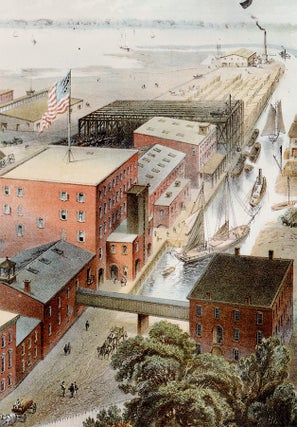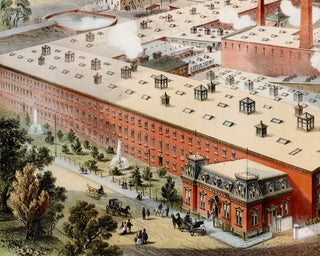Glen Cove Starch Works, Glen Cove, L. I. Duryeas’ Satin Gloss Starch, Duryeas’ Improved Corn Starch, &C.
New York: Glen Cove Starch Works, [c. 1880]. Major & Knapp, lithographers. Chromolithograph, 27.125” x 30” plus margins. A richly detailed and lively factory view, reflecting and idealizing the expansion of American industry in the second half of the nineteenth century. This pleasing chromolithograph, executed by leading New York lithographers Major & Knapp, depicts the extensive and variegated complex of a prominent starch manufacturer, situated on the shores of Glen Cove, Long Island. A mansard-roofed office building at the front is attached to an elongated brick structure, graced by park-like landscaping with two large fountains. Adjoining this are many additional structures, stretching toward the water’s edge, terminating in a wharf that juts out into the cove. Workers are seen in the various yards about the factory, while the fashionably dressed stroll at their leisure or drive horse-drawn vehicles on the avenue along the front. Pleasure boaters are seen in the waters on the lower right, while a number of vessels occupy a canal along the right side of the complex. Sailboats and a ship or two dot the waters in the distance. Here, it would seem, industry coexists peacefully with pleasant outdoor recreations. Plumes of apparently innocuous smoke rise from various smokestacks, suggesting the productivity within, and an American flag flaps in the breeze high atop one structure, lending the scene a note of patriotism. Around 1828, Glen Cove became one of the foremost passenger terminals for vessels en route to New York City. A bustling tourist industry soon sprang up, in addition to a second-home resort community in the Hempstead Harbor vicinity for well-to-do New Yorkers such as J. P. Morgan. The region became known as the ‘Gold Coast.’ During the 1850s, Duryeas’ Corn Starch Manufacturing Company relocated their central plant from Oswego, New York, to the south side of Glen Cove Creek. At the close of the Civil War, the plant was the world’s largest producer of starch. At its apogee, the factory covered some 30 acres and employed over 700 workers. The massive plant housed chemical buildings, blacksmith shops, corn elevators, a cooperage, box factory, lumberyard, print shop, etc. A company town formed around the factory, with living quarters for employees and a company store. The plant stayed in business until 1900 and burned down in 1906. While this advertising print projects an image of a manufacturing operation in harmony with the environment, the factory spewed waste into Glen Cove Creek, resulting in a highly obnoxious smell that pervaded the region. A handsome, idealized depiction of later nineteenth century American industry. CONDITION: Very good. REFERENCES: Petrash, Antonia; Carol Stern; and Carol McCrossen. History of Glen Cove at glencovelibrary.org
Item #3559
Sold




